
Overly dark loaves from Challenger bread pan

Just over a year since I started my bread baking journey. I committed to the Tartine method from the start and have made good progress up until the baking. I make two loaves once a week.
I use a Challenger bread pan and began to get nice looking loaves, but they had a sticky crumb that left a heavy film on the bread knife. So I began extending the baking time, first to 1/2 hour (up from 25 min in recipe), then adding 15 minutes after turning the oven off, and most recently adding 20-25 minutes with oven off. I use a compact (24") Gaggenau oven, in convection mode during the initial lid-on bake at 500-degrees, and switch to normal oven mode after reducing to 450-degrees and then taking the lid off. Except for toggling the convection mode and my extended bake times, this is all according to recipe directions in Tartine 3 cookbook.
So while I seem to have overcome the sticky crumb problem, now I'm getting overly dark loaves and a burned bottom crust.
Couple more details: I continue to use the convection mode during the lid-on bake phase because in normal mode the oven won't heat up to 500-degrees (only about 450 or so, even after 45-60 minutes). And when I do remove the lid, I put the lower bread pan into the upturned lid during the final bake (per Challenger recommendation to eliminate burned crust).
Attached photos show loaf at mid-bake, just after lid came off, then the final dark loaf, the bottom crust, and the loaf during the bake.
I'm wondering if I need a new oven! --although I see in another post that your oven is similar in size to mine. I'd be grateful for your suggestions.
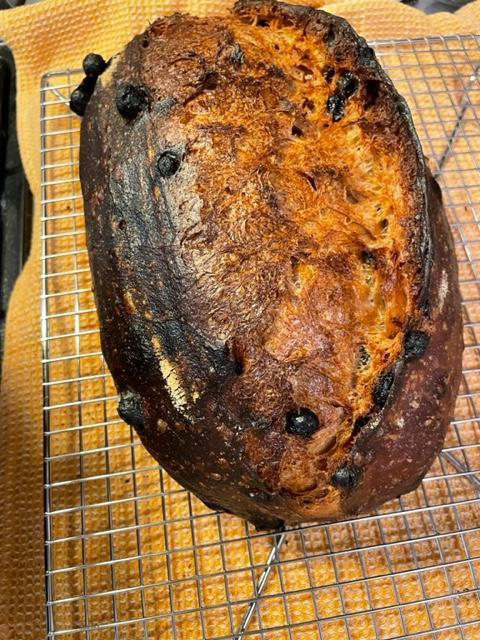
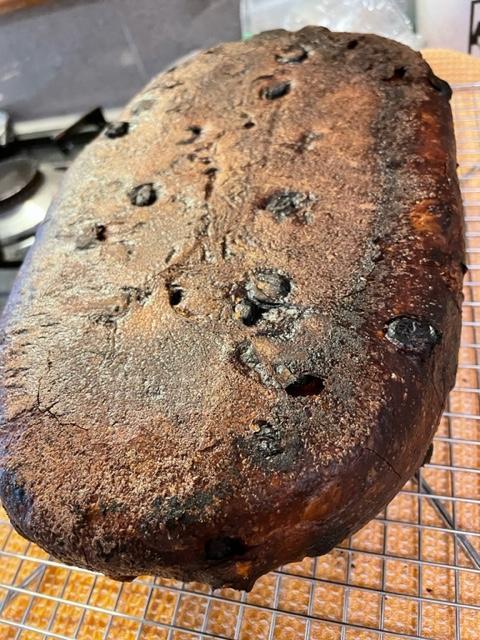
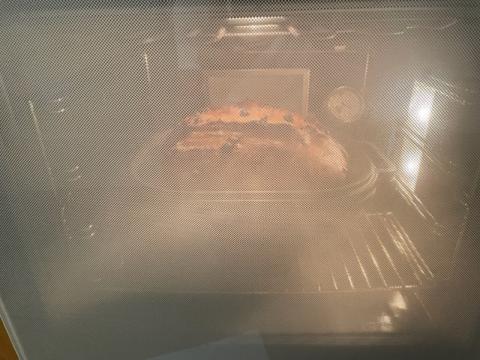


I don't have a Challenger pan so what I say may not be worth much. I have baked a number of loaves in one or another Dutch Ovens, which are at least in the same ballpark.
First of all, if the outside consistently cooks more than the interior, the oven temperature is too high. The ideal temperature will get both done at the same time. Also, 500 deg F strikes me as being rather high, although the pan could be a factor. I bake most of my loaves free-standing on a baking steel, and they would burn up at 500 deg. Also, larger loaves need a lower baking temperature (so the crust doesn't overcook before the interior is ready), and I believe the Challenger can take a pretty large loaf. The difference between baking a 1-lb loaf and a 2-lb loaf could easily be 25 - 35 deg F.
Second, if the bottom gets cooked more than the top, then either the oven temperature is high or the bottom needs to be protected. That's assuming that the oven has been preheated long enough so that all the parts get completely heat-soaked, including the Challenger. That's likely to be 45 minutes to an hour, at least. In baking with black DOs, I persistently got scotched bottoms until I learned to fold an aluminum foil disk to fit and put it into the bottom of the DO. I covered it with a parchment paper disk so that dough wouldn't get stuck in any creases. Some people will tell you to put corn meal or seminola into the pan, but I think the foil disk is better because it doesn't burn and it's not messy.
For gummy bread, it's best to check the interior temperature when you think it's done, using a probe-type "instant" read thermometer. Some sources will tell you to get the temperature to 210 deg F in the middle, but it doesn't need to be that high. Most of my loaves come out around 206 - 208 deg. They can be cooler, but then they are more likely to have the crust soften up because of the extra moisture coming out of the body of the loaf. (Those temperatures are at sea level. If you are at a much higher altitude then look up the boiling temperature of water there and make the interior temperature 4 or 5 deg F lower).
I hope there's something useful here!
TomP
TomP, kqbui, CalBeach, and ifs,
Thank you all for sharing your tips. I've been trying to incorporate them in a logical manner into my bakes these past few weeks--not with perfect success yet but I'm determined to get there.
All these tweeks to achieve good results has me pondering the physics of various oven types--oven volume, heating "horsepower," heat retention capability, steam injection--and the differences between home and commercial ovens, and what kind of equipment cookbook authors use who don't mention such tweeks. Lots of variables in the baking process, to be sure, but I'm learning that this must be a labor of love above all else!
Tom, thank you for your excellent suggestions last summer. Using the foil and parchment paper and the foil shields suggested in other comments, I'm now making nice looking loaves with good coloring on all sides. Here are a couple loaves of cranberry-pecan I like with breakfast. About 30% Cairnsprings WW, 30% KA and Cairnsprings bread flour, and 30% KA AP, the remainder dark rye.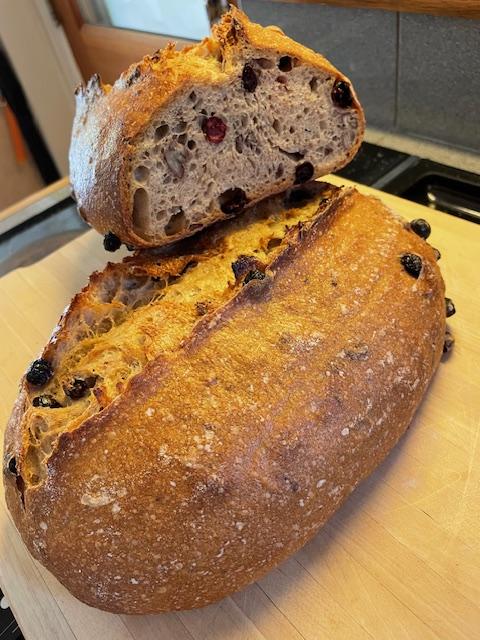
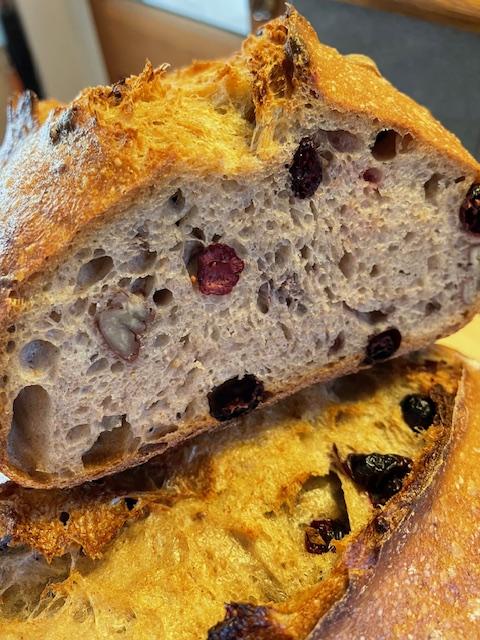
Honey and the unsweetened cranberries makes a nice sweet-tart combination.
Well done! You've really nailed it. Thanks for letting us know how it all worked out.
TomP
With my challenger, I bake at 500 for 20 minutes with lid on, and then lid off for ~25 minutes at 450. However, 10 minutes after I take the lid off (so this is 30 minutes in and the oven has been at 450 for 10 minutes), I like to place underneath the loaf a rectangle of foil made of two layers of foil. I rotate the loaf, place the foil rectangle underneath, and then place an additional two foil shields on the sides of the loaf. The foil shields are long rectangle shapes and don't cover the very top of the loaf (to allow browning of the top, since it's only the sides that are really browned at this point). If the top is browning too much (usually 40 minutes in), I then add another foil strip on top of the loaf for the last 3-5 minutes to bring it to 43-45 minutes total baking time. I re-use the foil strips for subsequent bakes. This gives me a nice even brown and a fully baked crumb. Opening the oven door also will reduce the oven temperature naturally. As Tom has mentioned, you can experiment with oven temperature as well. Note that this method of 500 for 20 and 450 for 25 minutes is probably an optimal baking time for higher hydration doughs (I'm thinking 83% hydration+). With lower hydration, you can lower the baking time and temperature and opt to not use foil at all. You could also just do 40 minutes total baking time but retain the foiling 30 minutes in.
kqbui, the comments I just posted to Tom apply to you also. Your foil shields are now a routine part of my baking and the results are excellent.
FWIW- Challenger recommendation and my experience
Capture1.JPG
Jalapeño Cheese Bread 8.12.2023 C2.JPG
Capture2.JPG
Tony
I usually bake the last 10-15 minutes outside of the Dutch oven to reduce burning on the bottom
Vary the time under and without top to adjust darkness of laof.
If too dark, leave top o n longer next time, it to light leave it on shorter.
If the loaf is cooked more under the hood it will not be exposed as long and will darken less.
I have developed a sense of time with my Challenger that lets me adapt to the loaves. Intuition?
Just from my own experience and others whom I've talked with over the years, convection baking is not good for bread. I also agree with the other reply, leave the cover on longer. My oven has the option of turning on/off convection fan.
I wouldn't use the convection feature of my oven to bake bread, ovens are bad enough about drying the crust without adding a fan to dry it out even faster. Even worse if you have a gas oven (like I do) instead of an electric.
I wouldn't blame the pot for things burning, I would look at temperature and time to solve that problem.